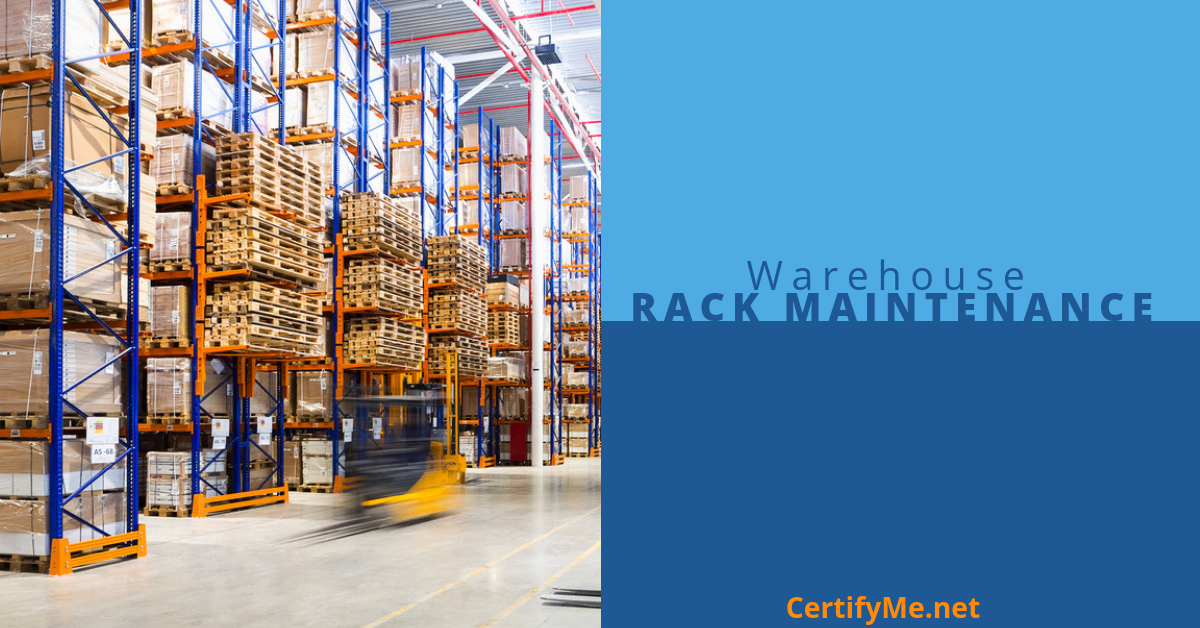The Importance of Warehouse Rack Maintenance

It’s easy to undervalue the need for regularly inspecting and maintaining warehouse rack systems. This often results in these tasks being postponed or overlooked. Just because racking looks sturdy doesn’t mean that it’s safe.
Rack Failure Causes
Common causes of rack damage include:
- Collisions from lift trucks operated by careless or untrained drivers
- Overloading and misuse of racks
- Poorly designed system layouts
Signs of failure aren’t always obvious to the untrained eye. Rack damage can be hidden from view by shelves stacked with inventory. These include bent columns, sheared or crushed frames, damaged footplates, loose or missing anchor bolts, and more.
Rack damage can also be caused by workers overloading shelves to save time and fill empty spaces without regard to weight limitations. Changes in the types and weights of inventory being stored may require adjustments in the way the rack system is used. These changes are sometimes overlooked or ignored, which can result in a potentially unsafe workplace.
Determining Rack Soundness and Safety
Don’t wait for an accident to happen. The first step in determining the condition of warehouse racks is to establish a regular inspection schedule. These rack damage checks should be performed by a qualified individual who’s familiar with storage rack systems. Inspections should be conducted at least annually, and preferably more often. Incidents such as a lift truck collision or earthquake warrant re-inspections. Increased warehouse activity and heavier traffic are also reasons for an inspection since they increase the chances of racks sustaining collision damage.
Rack systems’ uses can change as a business evolves. Most systems, however, are designed for specific applications and include limitations on configurations, rack heights, and max load. When these change, racks sometimes suffer damages that go undetected.
Changes in building codes can also affect the inspection schedule. A rack system installed under previous codes may have been grandfathered in. However, the updated codes will apply if the system is reconfigured. This would call for a new inspection.
Other Rack Inspection Considerations
Inspections go beyond just checking the racks. The Rack Manufacturers Institute (RMI) recommends that when inspecting a warehouse rack system, the following conditions also be taken into consideration:
- Product Value. Generally speaking, the less expensive the items being stored, the higher the likelihood the rack will be damaged through operator carelessness
- Aisle Clearances. The narrower the aisles between racks, the more likely lift trucks and other material handling equipment will hit them
- Transfer Aisles. Racks in rows with intersecting transfer aisles are more likely to get damaged
- Previously Damaged Areas. It’s likely that areas where racks have been damaged in the past will be again
Extra attention should be given when inspecting racks in these high-risk areas.
Rack Inspections
Following an inspection, damaged racks will need to be repaired or replaced. It’s recommended that a rack design engineer is involved with both the inspection itself and the repairs that follow. This verifies that the rack’s structural integrity meets or exceeds minimum standards and that the system is properly configured. An engineer’s involvement will also ensure that the repaired rack is safe and ready to use.
The purpose of rack inspections is to determine whether the racks are damaged and to verify that the loads are within the limits the rack was designed to hold. Seizmic Engineering CEO and rack design engineer Sal Fateen recommends a rack inspection process that starts with reviewing a floor plan and elevation of the racks, along with load limits and other information taken from the original permits.
Here are the items Sal suggests checking during rack inspections:
- Columns. Check for plumbness and signs of impact damage. Pay particular attention to corner dents, which are more serious than dents in the column’s side or face.
- Base Plates and Anchors. Confirm that plates are connected to the column with no breaks or cracks in the welds. Check to see that the anchor bolts are installed correctly and that the nuts have been properly torqued.
- Frame Bracing. Check for shears, bends, buckles, twists and loose or missing bracing.
- Row Spacers and Structural Frame Ties. Inspect the locations, quantities, and types of all ties and spacers.
- Beams. Look for dents in beams deeper than 0.25 inch and note their locations.
- Column Connectors and Locking Mechanisms. Check for damage to tabs, studs, bolts and other beam/column connectors.
- Accessories. Inspect wire decks, crossbars and other accessories as to their general condition.
All proposed repairs should be reviewed and approved by either an independent engineer or a rack design professional from the manufacturer or supplier. Without an engineer’s approval, there’s no guarantee that the repair is sound and the rack is safe to use.
Storage Planning and Workplace Safety
When designing a warehouse storage system, safety is a top priority. Possible consequences of poorly designed or unstable storage racks include:
- Serious or fatal worker injuries
- Damaged or destroyed inventory
- Operational downtime
- Costs to repair or replace the racks and OSHA fines
All of these can be avoided through proper storage system design, installation, and maintenance.
To prevent overloading and uneven weight distribution, the weight, shape and size of the items to be stored need to be considered when choosing rack storage. The manner in which they’re stored will affect the system’s stability. Larger and heavier items should be stored on lower shelves to minimize the risk of forklift damage or injury. Aisles between racks need to be properly spaced to allow forklifts to move safely.
Many warehouse injuries involve forklifts driven by operators lacking the right training. Hiring properly trained operators, such as those who have completed CertifyMe.net’s OSHA-approved Online Forklift Training and Certification program is absolutely essential for reducing the risk of workplace accidents involving forklifts.
With proper rack storage system design and maintenance, along with adequately trained equipment operators, your warehouse will be a safer and more productive workplace.